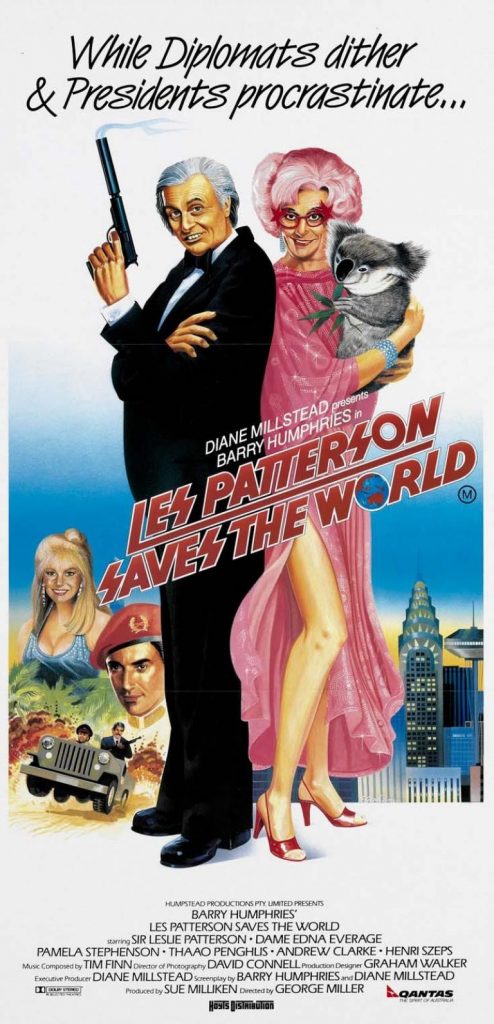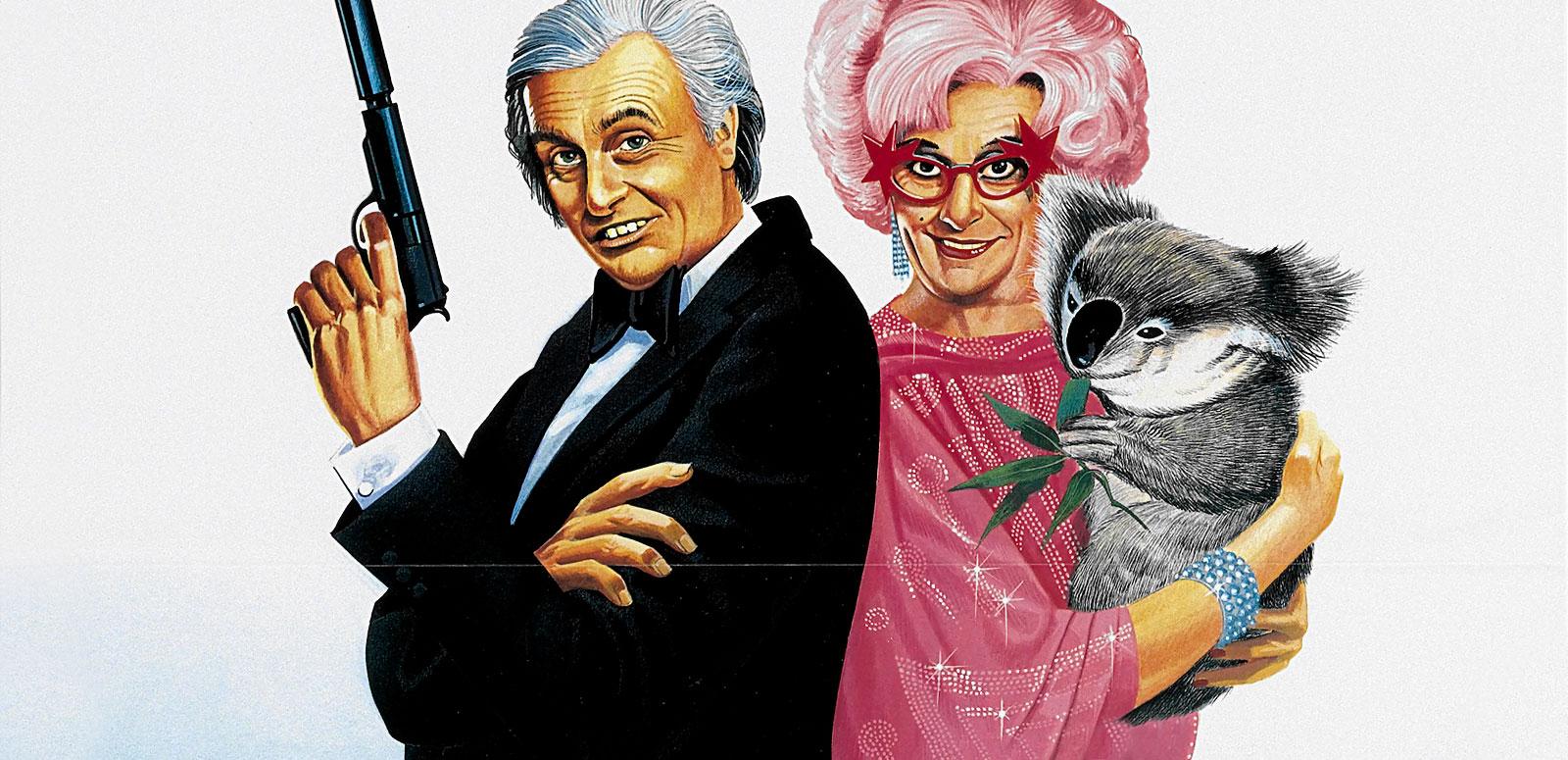Help keep The Curb independent by joining our Patreon.
For the 2016 Archibald Prize competition — awarding the best portrait paintings in Australia — the top honour was given to a portrait of Barry Humphries by artist Louise Hearman. Consequently, over a three-month period Humphries’ award-winning portrait adorned the walls of the Art Gallery of New South Wales, one of Australia’s premier cultural institutions. Such respectability, alas, continues to evade 1987’s Les Patterson Saves the World.
David Stratton provides an evocative thumbnail of Patterson for those unfamiliar with Humphries’ second most famous creation, describing him as:
A kind of latter-day Toby Belch, a larger-than-life caricature of a nouveau-rich bon vivant — belching, farting, womanising and chundering his way through life with scant regard for the sensibilities of others.
(The Avocado Plantation, pp. 306–307)
For readers ambivalent about celebrating Australia Day, Les Patterson Saves the World could be either the absolute worst or most peculiarly apt viewing, showcasing as it does the ultimate ugly Australian and apotheosis of Antipodean white male privilege.
Directed by George Miller of The Man from Snowy River fame — not to be confused with George Miller of Mad Max and Babe fame — Les Patterson Saves the World brought Humphries’ lecherous, vulgar, perpetually intoxicated elder statesman — whom he’d been performing on stage and television for over a decade — to the silver screen with mixed results. Following a spectacular faux pas at the United Nations, Patterson’s diplomatic career is on the skids. In cahoots with the US President, Prime Minister Bob Hawke assigns Patterson to the Middle East, where he’ll be executed for his blunder. When a coup usurps his executors, Patterson is reinstated as an Australian diplomat, but then uncovers another plot: to poison people worldwide through toxic toilet seats.
Whether you’re a fan or detractor of Humphries’ work, there is no denying he’s fascinating. Tony Moore writes of Humphries:
A conservative contrarian while many in his generation were moving left, Humphries nevertheless retained a bohemian delight in transgression that makes him a radical. While Humphries the artist indulges elitist inclinations, the performer loves the applause from the crowd.
(The Barry McKenzie Movies, p. 49)
That contradiction between conservative and transgressor, elitist and gleeful vulgarian, is embodied in the character of Patterson. Les enables Humphries to parody the aspects of Australian culture that both repulse and fascinate him, in turn expressing cultural cringe, delighting in it, and sadistically pointing it back towards viewers. The film surrounding Patterson also serves as a vehicle for this: like the Barry McKenzie films of the previous decade co-written by Humphries, Les Patterson Saves the World both recoils from and gladly perpetuates local stereotypes. An early scene showing marsupials roaming the streets of Sydney is one instance of the film celebrating, denigrating, and perpetuating clichéd perceptions of Australia.
Humphries’ parodic sweep is broad and inclusive, and perhaps unsurprising given this take-no-prisoners approach, the film was not warmly received or financially lucrative, and earned the wrath of no less than future Prime Minister Paul Keating. In marked contrast, his previous film project, Barry McKenzie Holds His Own, wrangled a Gough Whitlam cameo. Indeed, whilst reviled in their time, the Barry McKenzie films were commercial successes and later developed an air of counter-culture respectability, a coda that eludes Les Patterson Saves the World.
That probably shouldn’t be unsurprising. There’s a spotty tradition of adapting successful Australian television and stage comedies to film: see also The Wog Boy, Fat Pizza, Housos, and Kath and Kim. Quality-wise, the legacy is patchy, and Les Patterson Saves the World proved a dubious investment. As Humphries himself wryly laments in one of the DVD’s special features, it “seemed like a good idea at the time”. He notes that similarities between the film’s HELP virus and the very topical, very serious AIDS virus did not help his film’s cause.
In 2021, on the heels of a year in which a pandemic has killed almost 2 million worldwide, one might be forgiven for not finding HELP particularly funny. Cancel culture has also been pervasive in the past year, impacting creators ranging from J.K. Rowling to Australia’s Chris Lilley. The latter offers some yardstick for how viewers today might react to cultural and gay stereotypes in Les Patterson Saves the World. Television audiences recently expressed outrage at Grease for its sexism, racism, and homophobia, characteristics seemingly hidden in plain sight over its 42 years as a beloved movie. Said viewers would be apoplectic at Les Patterson Saves the World, as said traits are not so much hidden in plain sight as paraded like carnival grotesqueries.
Despite the rhetoric of failure and offence surrounding the film, Les Patterson Saves the World is at times quite funny. For stretches it isn’t, but that’s okay: though it helps, a comedy does not have to be consistently funny to be interesting, just as an action film does not have to be exhilarating, or a horror film scary, and so on. With its garish sense of style and inflated sense of bombast, the film is never less than watchable, even if the jokes don’t all land.
As noted above, director Miller had earlier helmed the box office success The Man from Snowy River, along with the Ned Kelly television series The Last Outlaw and episodes of the prestige series Anzacs. Banjo Patterson, Ned Kelly, the Anzacs: that’s a decent smattering of national iconography to dabble in, and he did so with panache and success. Les Patterson Saves the World took some of the wind of respectability from his sails, but his work on the film was solid, giving the whole tacky affair a professional sheen.
The cast includes a number of familiar faces, likewise doing their professional best: comedienne Pamela Stephenson as Patterson’s love interest, Andrew Clarke as an official tasked with babysitting Patterson, Graham Kennedy (briefly) as a member of the Hawke upper echelon, Joan Rivers as the first female U.S. president, and the late, great Hugh Keays-Byrne as a heavy. But of course, as creator, co-writer, and star, Humphries dominates the film and provides its gravitational and creative centre. One can’t really critique his performances as Patterson or Dame Edna Everage, who also plays a prominent role in proceedings: Humphries simply is Patterson and Edna, and excels at being them.
Les Patterson Saves the World is very much a buyer beware film, but if the poster below amuses you, or the trailer below stirs a giggle, in all likelihood you will find something to enjoy about it.
Director: George Miller
Cast: Barry Humphries, Pamela Stephenson, Taao Phenglis
Writers: Barry Humphries, Diane Millstead




